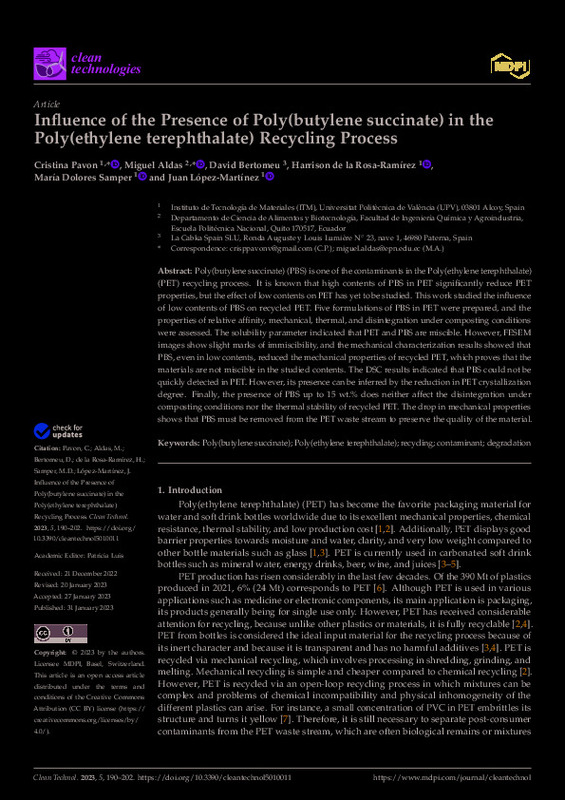JavaScript is disabled for your browser. Some features of this site may not work without it.
Buscar en RiuNet
Listar
Mi cuenta
Estadísticas
Ayuda RiuNet
Admin. UPV
Influence of the Presence of Poly(butylene succinate) in the Poly(ethylene terephthalate) Recycling Process
Mostrar el registro sencillo del ítem
Ficheros en el ítem
| dc.contributor.author | Pavón-Vargas, Cristina Paola
|
es_ES |
| dc.contributor.author | Aldás, Miguel
|
es_ES |
| dc.contributor.author | Bertomeu, David
|
es_ES |
| dc.contributor.author | Rosa-Ramírez, Harrison de la
|
es_ES |
| dc.contributor.author | Samper, María-Dolores
|
es_ES |
| dc.contributor.author | López-Martínez, Juan
|
es_ES |
| dc.date.accessioned | 2023-03-27T18:01:29Z | |
| dc.date.available | 2023-03-27T18:01:29Z | |
| dc.date.issued | 2023-01-31 | es_ES |
| dc.identifier.uri | http://hdl.handle.net/10251/192619 | |
| dc.description.abstract | [EN] Poly(butylene succinate) (PBS) is one of the contaminants in the Poly(ethylene terephthalate) (PET) recycling process. It is known that high contents of PBS in PET significantly reduce PET properties, but the effect of low contents on PET has yet to be studied. This work studied the influence of low contents of PBS on recycled PET. Five formulations of PBS in PET were prepared, and the properties of relative affinity, mechanical, thermal, and disintegration under composting conditions were assessed. The solubility parameter indicated that PET and PBS are miscible. However, FESEM images show slight marks of immiscibility, and the mechanical characterization results showed that PBS, even in low contents, reduced the mechanical properties of recycled PET, which proves that the materials are not miscible in the studied contents. The DSC results indicated that PBS could not be quickly detected in PET. However, its presence can be inferred by the reduction in PET crystallization degree. Finally, the presence of PBS up to 15 wt.% does neither affect the disintegration under composting conditions nor the thermal stability of recycled PET. The drop in mechanical properties shows that PBS must be removed from the PET waste stream to preserve the quality of the material. | es_ES |
| dc.description.sponsorship | This research is a part of grant PID2020-116496RB-C22, funded by MCIN/AEI/10.13039/ 501100011033. C.P. acknowledges the Santiago Grisolía Fellowship (GRISOLIAP/2019/113) from Generalitat Valenciana. The Microscopy Services at UPV are also acknowledged for their help in collecting and analyzing the images | es_ES |
| dc.language | Inglés | es_ES |
| dc.publisher | MDPI AG | es_ES |
| dc.relation.ispartof | Clean Technologies | es_ES |
| dc.rights | Reconocimiento (by) | es_ES |
| dc.subject | Poly(butylene succinate) | es_ES |
| dc.subject | Poly(ethylene terephthalate) | es_ES |
| dc.subject | Recycling | es_ES |
| dc.subject | Contaminant | es_ES |
| dc.subject | Degradation | es_ES |
| dc.subject.classification | CIENCIA DE LOS MATERIALES E INGENIERIA METALURGICA | es_ES |
| dc.title | Influence of the Presence of Poly(butylene succinate) in the Poly(ethylene terephthalate) Recycling Process | es_ES |
| dc.type | Artículo | es_ES |
| dc.identifier.doi | 10.3390/cleantechnol5010011 | es_ES |
| dc.relation.projectID | info:eu-repo/grantAgreement/AEI/Plan Estatal de Investigación Científica y Técnica y de Innovación 2017-2020/PID2020-116496RB-C22/ES/OBTENCION DE NANOCOMPOSITES DE ORIGEN BIO A PARTIR DE RESIDUOS LIGNOCELULOSICOS PARA SU USO EN FILMS MULTICAPA/ | es_ES |
| dc.relation.projectID | info:eu-repo/grantAgreement/AEI//PID2021-123753NA-C33//DESARROLLO DE ESCALADO SEMIINDUSTRIAL DE NANOCOMPUESTOS POLIMÉRICOS BIODEGRADABLES MODIFICADOS CON ACEITES VEGETALES/ | es_ES |
| dc.relation.projectID | info:eu-repo/grantAgreement/GVA//GRISOLIAP%2F2019%2F113//AYUDA SANTIAGO GRISOLIA PROYECTO DESARROLLO DE COMPATIBILIZANTES NATURALES/ | es_ES |
| dc.rights.accessRights | Abierto | es_ES |
| dc.contributor.affiliation | Universitat Politècnica de València. Escuela Politécnica Superior de Alcoy - Escola Politècnica Superior d'Alcoi | es_ES |
| dc.contributor.affiliation | Universitat Politècnica de València. Instituto de Tecnología de Materiales - Institut de Tecnologia de Materials | es_ES |
| dc.description.bibliographicCitation | Pavón-Vargas, CP.; Aldás, M.; Bertomeu, D.; Rosa-Ramírez, HDL.; Samper, M.; López-Martínez, J. (2023). Influence of the Presence of Poly(butylene succinate) in the Poly(ethylene terephthalate) Recycling Process. Clean Technologies. 5(1):190-202. https://doi.org/10.3390/cleantechnol5010011 | es_ES |
| dc.description.accrualMethod | S | es_ES |
| dc.relation.publisherversion | https://doi.org/10.3390/cleantechnol5010011 | es_ES |
| dc.description.upvformatpinicio | 190 | es_ES |
| dc.description.upvformatpfin | 202 | es_ES |
| dc.type.version | info:eu-repo/semantics/publishedVersion | es_ES |
| dc.description.volume | 5 | es_ES |
| dc.description.issue | 1 | es_ES |
| dc.identifier.eissn | 2571-8797 | es_ES |
| dc.relation.pasarela | S\482912 | es_ES |
| dc.contributor.funder | Generalitat Valenciana | es_ES |
| dc.contributor.funder | AGENCIA ESTATAL DE INVESTIGACION | es_ES |
| dc.subject.ods | 08.- Fomentar el crecimiento económico sostenido, inclusivo y sostenible, el empleo pleno y productivo, y el trabajo decente para todos | es_ES |








